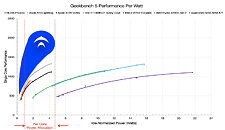
Qualcomm Snapdragon X Elite and X Plus SKU Lineup Leaks Out
A Qualcomm Snapdragon X Elite "X1E80100" processor model was leaked in late February—it is likely that several SKUs have been distributed for evaluation purposes. Geekbench Browser is normally a good source of pre-release information—a benched Lenovo "83ED" laptop was spotted last week. That entry outed a "Snapdragon X Elite-X1E78100" processor, sporting twelve cores with maximum frequencies of 3.42 GHz. The latest exposures arrive courtesy of a Baidu forum post. Qualcomm has publicly revealed its "X Elite" range of Nuvia-designed Oryon core CPUs, but insiders have uncovered an additional "X Plus" family—probably a series of less expensive/lower spec alternatives.
The leaked list of SKUs does not include any detailed information—it reconfirms the existence of Qualcomm's top-tier X1E80100 and X1E78100 models and the presence of Adreno iGPUs. Driver information points to Qualcomm's next-gen integrated graphics solutions being readied for modern APIs: DX11, DX12, and OpenGL. The firm's ARM-based mobile PC CPUs are expected to launch within a mid-2024 period, according to the company's official statements—insiders believe that the NPU-enhanced Snapdragon X processors are destined to debut within next-gen "Windows 12" AI-centric notebooks.
The leaked list of SKUs does not include any detailed information—it reconfirms the existence of Qualcomm's top-tier X1E80100 and X1E78100 models and the presence of Adreno iGPUs. Driver information points to Qualcomm's next-gen integrated graphics solutions being readied for modern APIs: DX11, DX12, and OpenGL. The firm's ARM-based mobile PC CPUs are expected to launch within a mid-2024 period, according to the company's official statements—insiders believe that the NPU-enhanced Snapdragon X processors are destined to debut within next-gen "Windows 12" AI-centric notebooks.





























